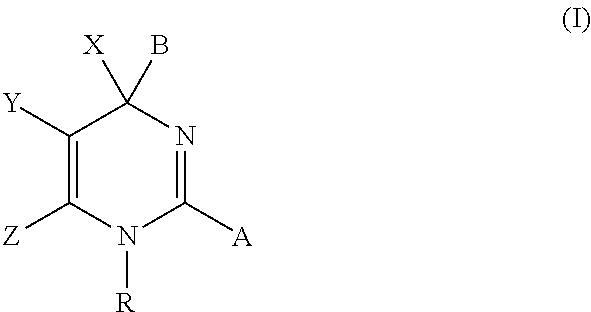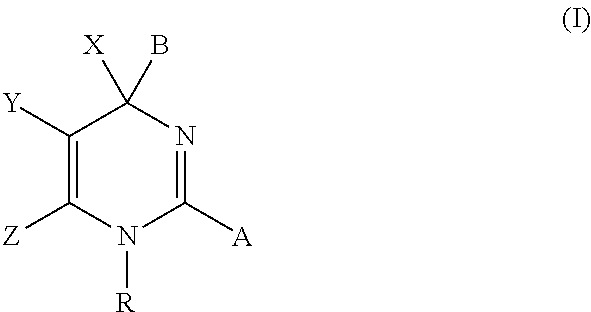Hepatitis B antiviral agents
a technology of antiviral agents and hepatitis b, applied in the field of new antiviral agents, can solve the problems of unmet global medical needs, hbv infection remains a major public health problem, and affects approximately 2 billion people worldwide, and the burden of chronic hbv infection remains significan
- Summary
- Abstract
- Description
- Claims
- Application Information
AI Technical Summary
Benefits of technology
Problems solved by technology
Method used
Image
Examples
example 1
[0233]
Step 1a
[0234]To a solution of ethyl 2-nitroacetate (0.941 g, 7.07 mmol) in DMF (50 ml) at rt was added NaH (60% in mineral oil, 0.283 g, 7.07 mmol). The resulting solution was stirred at rt for 1 h before being cooled down to 0° C. Intermediate 1 (2.000 g, 3.54 mmol) was added at 0° C. The resulting solution was stirred at 0° C. for 2 h and then at rt overnight. It was quenched with saturated NH4Cl aq and diluted with DCM and EtOAc. The organic layer was washed with water (*1), brine (*2), dried (Na2SO4) and concentrated. The residue was chromatographed (silica, hexanes / EtOAc) to afford the desired compound as yellow foam (0.903 g, 41%). ESI MS m / z=617.03, 619.03 [M+H]+.
Step 1b
[0235]To a solution of the compound from step 1a (450 mg, 0.728 mmol) and 1-methyl-3-(tributylstannyl)-1H-pyrazole (351 mg, 0.947 mmol) in toluene (12 ml) at rt was added Pd(Ph3P)4 (126 mg, 0.109 mmol). The mixture was degassed 3 times before being heated at 135° C. using a microwave reactor for 45 min. ...
example 2
[0241]
Step 2a
[0242]To a solution of Example 1 (10.0 mg, 0.019 mmol) in DCM (2 ml) at rt was added 4N HCl in 1,4-dioxane (0.095 ml, 0.378 mmol). The resulting suspension was stirred at rt for 1 h. More 4 N HCl in 1,4-dioxane (0.095 ml, 0.378 mmol) was added. The suspension was stirred at rt for 1 h before being concentrated. The residue was co-evaporated with toluene and dried under vacuum to afford the desired compound as yellow foam (8.5 mg, 100%). ESI MS m / z=429.11, 431.11 [M+H]+.
Step 2b
[0243]To a solution of the compound from step 2a (8.5 mg, 0.019 mmol) in pyridine (1 ml) at rt was added cyclopropanesulfonyl chloride (5.34 mg, 0.038 mmol). The resulting mixture was stirred at rt for 3 h and then heated at 30° C. overnight. DMAP (2.321 mg, 0.019 mmol) was added. The mixture was heated at 50° C. for 2 h before being allowed to cool down and quenched with water. It was concentrated. The residue was co-evaporated with toluene and chromatographed (silica, DCM / MeOH) to afford the titl...
example 3
[0245]
[0246]The title compound was obtained by chiral HPLC separation of Example 2 with Chiralpak OD-H column (eluting with 30% i-PrOH in hexanes). ESI MS m / z=533.10, 535.10 [M+H]+.
Alternative Route for the Preparation of Example 3
[0247]
Step 3a
[0248]To a suspension of Intermediate 1 (3.00 g, 5.30 mmol) and ethyl 2-((diphenylmethylene)amino)acetate (1.985 g, 7.42 mmol) in toluene (54 ml) cooled at 0° C. was added O-Allyl-N-(9-anthracenylmethyl)cinchonidinium bromide (0.321 g, 0.530 mmol), followed by 50% KOH aq (17.68 ml, 265 mmol) dropwise. The mixture was vigorously stirred at 0° C. for 2 h before being diluted with saturated NaHCO3 aq and MTBE. The organic layer was washed with saturated NaHCO3 aq (*1), brine (*1), dried over Na2SO4 (s), filtered and concentrated. The residue was dried under vacuum to afford the desired compound as yellow foam (5.40 g), which was used directly for next step. ESI MS m / z=751.14, 753.14 [M+H]+.
Step 3b
[0249]A clear orange solution of the compound from...
PUM
| Property | Measurement | Unit |
|---|---|---|
| body weight | aaaaa | aaaaa |
| body weight | aaaaa | aaaaa |
| pH | aaaaa | aaaaa |
Abstract
Description
Claims
Application Information
 Login to View More
Login to View More - R&D
- Intellectual Property
- Life Sciences
- Materials
- Tech Scout
- Unparalleled Data Quality
- Higher Quality Content
- 60% Fewer Hallucinations
Browse by: Latest US Patents, China's latest patents, Technical Efficacy Thesaurus, Application Domain, Technology Topic, Popular Technical Reports.
© 2025 PatSnap. All rights reserved.Legal|Privacy policy|Modern Slavery Act Transparency Statement|Sitemap|About US| Contact US: help@patsnap.com



